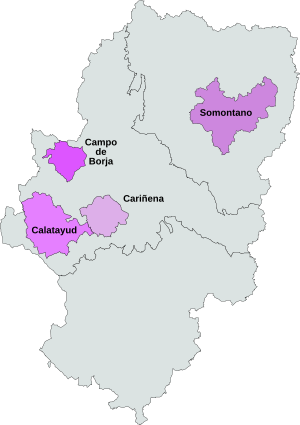Somontano facts for kids
| Wine region | |

|
|
| Official name | D.O.P Somontano |
|---|---|
| Type | Denominación de Origen Protegida (DOP) |
| Year established | 1984 |
| Country | Spain |
| No. of vineyards | 3,931 hectares (9,714 acres) |
| No. of wineries | 31 |
| Wine produced | 184,449 hectolitres |
| Comments | Data for 2016 / 2017 |
Somontano is a special wine region in Spain. It is known for making high-quality wines. The name "Somontano" comes from Latin and means "beneath the mountain." This is a perfect name because the area is located at the foot of the Pyrenees mountains.
The Somontano wine region was officially recognized in 1984. It is found in the Province of Huesca in the Aragon area of Spain. The main town for wine production here is Barbastro. The region has over 4,000 hectares of vineyards. That's a lot of land for growing grapes! About 500 different grape growers work in this area.
Contents
Geography of Somontano
The Somontano wine region has three main parts. These are the Mountains, the Somontano foothills, and the Plains. The Alcanadre river flows through the area. It divides Somontano into two sections.
The soil in Somontano is dark and made of sandy clay. It has a lot of lime. This soil is not super fertile, but it drains water well. This helps the grapevines grow deep roots. These deep roots can find more water and nutrients.
Climate in Somontano
The weather in Somontano is called continental. This means it has hot summers and cold winters. The Pyrenees mountains help to block cold winds from the north. Even so, winters can be very cold with freezing temperatures. Summers can be extremely hot. The temperature also changes a lot between day and night. On average, the region gets about 500 millimeters of rain each year.
History of Wine in Somontano
People have been growing grapes in the Somontano region for a very long time. They started at least as far back as the 2nd century BC. The Romans helped improve grape growing here. They brought new and better techniques.
During the Middle Ages, vineyards grew all over the province. Wine making became very successful. Local monasteries helped to manage and improve wine production. Later, in the 1800s, a disease called phylloxera attacked grapevines in France. This led to more sales and exports of Somontano wine.
Tourism and the Wine Route
The Ruta del Vino (Wine Route) of Somontano is a special way to explore the region. It is one of 13 official wine routes in Spain. Its goal is to encourage people to visit and learn about wine. This organization helps local businesses and wineries. It also gives visitors helpful information.
Besides wine, Somontano has many other interesting places to visit:
- The Sierra de Guara National Park: This park is famous for a sport called canyoning.
- The medieval village of Alquézar: A beautiful old village with a rich history.
- The River Vero Cultural Park: This park has over 60 ancient cave paintings. UNESCO has declared them a World Heritage Site.
- The Torreciudad Shrine: A religious site that is part of the Marian Route.
- The city of Barbastro: The main town in the Somontano region.
About half of the 31 wineries in Somontano welcome visitors. Most of them offer guided tours in Spanish, English, and French. A visit usually includes a tour of the winery and a wine tasting.
Grape Varieties Grown in Somontano
Many different types of grapes are allowed to be grown in Somontano. These grapes are used to make the region's famous wines.
- Red Grapes:
- White Grapes:
- Alcañón
- Chardonnay
- Garnacha Blanc
- Gewürztraminer
- Macabeo
- Riesling
- Sauvignon Blanc
Images for kids
See also
 In Spanish: Somontano para niños
In Spanish: Somontano para niños



